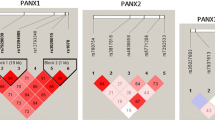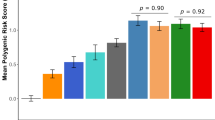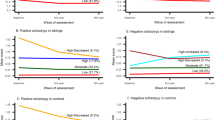Abstract
In a family study involving 139 probands with DSM-III-R catatonic schizophrenia and 543 first-degree relatives, we investigated age-specific morbidity risk according to Leonhard's clinical distinction between systematic and periodic catatonia. This dichotomy is based on different types of symptomatology, course, and outcome. In systematic catatonia the age-corrected morbility risk was 4.6%. In periodic catatonia, however, there was an age-corrected morbidity risk with homogenous psychoses of 26.9%, and more parents than siblings were affected. This points strongly to a major gene effect in periodic catatonia. Furthermore, a pairwise comparison of patients and their parents revealed patterns of anticipation, i.e., the probands' age at the onset of disease was significantly earlier than that of their parents (P<0.001). Similarly, anticipation was apparent in pedigrees with three successive generations affected. This inheritance pattern with homogenous psychoses and anticipation indicates that genes with trinucleotid repeat expansion or other repetitive elements affecting gene expression may be involved in the etiology of periodic catatonia. Thus, periodic catatonia as a specific clinical subtype of schizophrenia is a promising candidate for molecular genetic evaluation.
Similar content being viewed by others
References
American Psychiatric Association (1987) Diagnostic and statistical manual of mental disorders (DSM-III-R)3rd edn, revised. American Psychiatric Association, Washington, DC
Asherson P, Walsh C, Williams J, Sargeant M, Taylor C, Clements A, Gill M, Owen M, McGuffin P (1994) Imprinting and anticipation. Are they relevant to genetic studies of schizophrenia? Br J Psychiatry 164:619–624
Astrup C (1979) The chronic schizophrenias. Oslo, Universitätsforlaget
Baron M (1994) Novel strategies in molecular genetics of mental illness. Biol Psychiatry 35:757–760
Beckmann H, Franzek E (1992) Deficit of birth rates in winter and spring months in distinct subgroups of mainly genetically determined schizophrenia. Psychopathology 25:57–64
Beckmann H, Fritze J, Franzek E (1992) The influence of neuroleptics on specific syndromes and symptoms in schizophrenics with unfavourable long-term course. Neuropsychobiology 26:50–58
DeLisi LE (1992) The significance of age of onset for schizophrenia. Schizophr Bull 18:209–215
Franzek E, Beckmann H (1992) Schizophrenia: not a disease entity? A study of 57 long-term hospitalized chronic schizophrenics. Eur J Psychiatry 6:97–108
Harper PS, Harley HG, Reardon W, Shaw DJ (1992) Anticipation in myotonic dystrophy: new light on an old problem. Am J Hum Genet 51:10–26
Jakob H, Beckmann H (1986) Prenatal development disturbances in the limbic allocortex in schizophrenia. J Neural Transm 65: 303–326
Kendler KS, McGuire M, Gruenberg AM, O'Hare A, Spellman M, Walsh D (1993) The Roscommon family study. I. Methods, diagnosis of probands and risk of schizophrenia in relatives. Arch Gen Psychiatry 50:527–540
Kendler KS, McGuire M, Gruenberg AM, Walsh D (1994) Clinical heterogeneity in schizophrenia and the pattern of psychopathology in relatives: results from an epidemiologically based family study. Acta Psychiatr Scand 89:294–300
Leonhard K (1979) The classification of endogenous psychoses. Irvington, New York
Lesch KP, Stöber G, Balling U, Franzek E, Li SH, Ross CA, Newman M, Beckmann H, Riederer P (1994) Triplet repeats in clinical subtypes of schizophrenia: variation at the DRPLA (B37CAG repeat) locus is not associated with periodic catatonia. J Neural Transm 98:153–157
Li SH, McInnis MG, Margolis RL, Antonarakis SE, Ross CA (1993) Novel triplet repeat containing genes in human brain: cloning, expression, and length polymorphisms. Genomics 16:572–579
Lindvall M, Hagnell O, Öhman R (1986) Epidemiology of cycloid psychosis—a prospective longitudinal study of incidence and risk in the 1947 cohort of the Lundby study. Eur Arch Psychiatry Clin Neurosci 236:109–119
Maier W, Lichtermann D, Minges J, Hallmayer J, Heun R, Benkert O, Levinson DF (1993) Continuity and discontinuity of affective disorders and schizophrenia. Results of a controlled family study. Arch Gen Psychiatry 50:871–883
Mandel JL (1993) Questions of expansion. Nature Genet 4:8–9
McInnis MG, McMahon FJ, Chase GA, Simpson SG, Ross CA, DePaulo JR (1993) Anticipation in bipolar affective disorder. Am J Hum Genet 53:385–390
Propping P (1989) Psychiatrische Genetik Springer, Berlin Heidelberg New York
Ross CA, McInnis MG, Margolis RL, Li SH (1993) Genes with triplet repeats: candidate mediators of neuropsychiatric disorders. TINS 16:254–260
Scharfetter C, Nuesperli M (1980) The group of schizophrenias, schizoaffective psychoses, and affective disorders. Schizophr Bull 6:586–591
Slater E, Cowie V (1971) The genetics of mental disorders. Oxford Press, London New York
Stöber G, Franzek E, Beckmann H (1992) The role of maternal infectious diseases during pregnancy in the etiology of schizophrenia in the offspring. Eur Psychiatry 7:147–152
Stöber G, Franzek E, Beckmann H (1994) Schwangerschaftsinfektionen bei Müttern von chronisch Schizophrenen: Die Bedeutung einer differenzierten Nosologie. Nervenarzt 65:175–182
Stöber G, Franzek E, Beckmann H, Balling U, Riederer P, Lesch KP (1994) Periodic catatonia and anticipation: screening for nucleotide repeat expansions. Neuropsychopharmacology 10 (Suppl 2):268
Trostorff S von, Leonhard K (1990) Catamnesis of endogenous psychoses according to the differential diagnostic method of Karl Leonhard. Psychopathology 23:259–262
Ungvari GS (1993) The Wernicke-Kleist-Leonhard school of psychiatry. Biol Psychiatry 34:749–752
Vogel F, Motulsky AG (1986) Human genetics. Springer, Berlin Heidelberg New York
Warkentin S, Nilsson A, Karlson S, Risberg J, Franzen G, Gustafson L (1992) Cycloid psychosis: regional blood flow correlates of a psychotic episode. Acta Psychiatr Scand 85:23–29
Weissman MM, Merikangas KR, John K, Wickramaratne P, Prusorff BA, Kidd KK (1986) Family-genetic studies of psychiatric disorders. Arch Gen Psychiatry 43:1104–1116
Author information
Authors and Affiliations
Rights and permissions
About this article
Cite this article
Stöber, G., Franzek, E., Lesch, K.P. et al. Periodic catatonia: A schizophrenic subtype with major gene effect and anticipation. Eur Arch Psychiatry Clin Nuerosci 245, 135–141 (1995). https://doi.org/10.1007/BF02193085
Received:
Accepted:
Issue Date:
DOI: https://doi.org/10.1007/BF02193085




